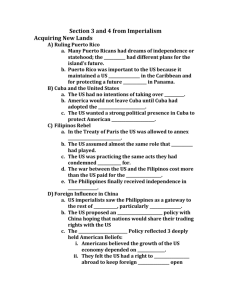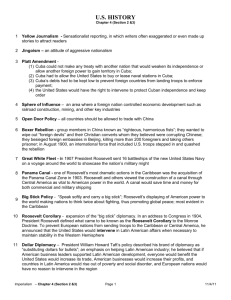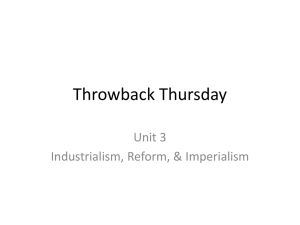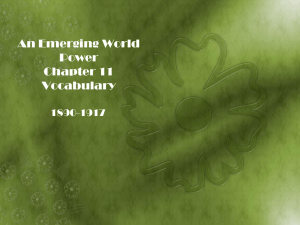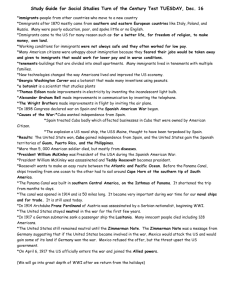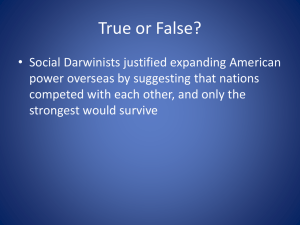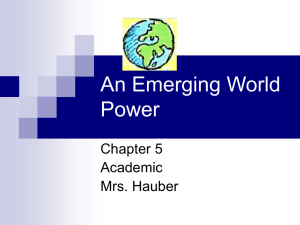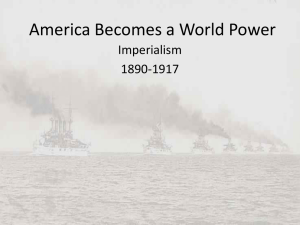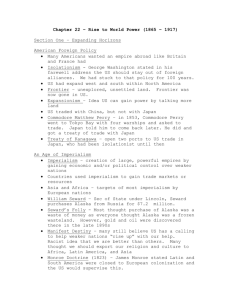Section 1: The Untied States Gains Overseas Territories END OF
advertisement
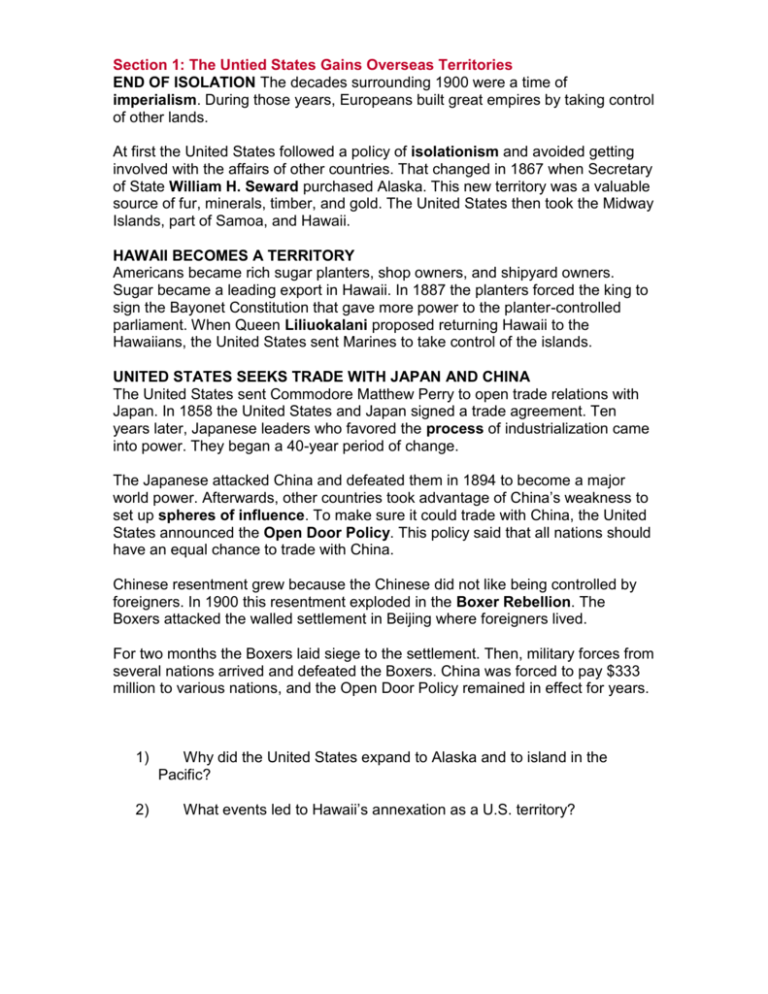
Section 1: The Untied States Gains Overseas Territories END OF ISOLATION The decades surrounding 1900 were a time of imperialism. During those years, Europeans built great empires by taking control of other lands. At first the United States followed a policy of isolationism and avoided getting involved with the affairs of other countries. That changed in 1867 when Secretary of State William H. Seward purchased Alaska. This new territory was a valuable source of fur, minerals, timber, and gold. The United States then took the Midway Islands, part of Samoa, and Hawaii. HAWAII BECOMES A TERRITORY Americans became rich sugar planters, shop owners, and shipyard owners. Sugar became a leading export in Hawaii. In 1887 the planters forced the king to sign the Bayonet Constitution that gave more power to the planter-controlled parliament. When Queen Liliuokalani proposed returning Hawaii to the Hawaiians, the United States sent Marines to take control of the islands. UNITED STATES SEEKS TRADE WITH JAPAN AND CHINA The United States sent Commodore Matthew Perry to open trade relations with Japan. In 1858 the United States and Japan signed a trade agreement. Ten years later, Japanese leaders who favored the process of industrialization came into power. They began a 40-year period of change. The Japanese attacked China and defeated them in 1894 to become a major world power. Afterwards, other countries took advantage of China’s weakness to set up spheres of influence. To make sure it could trade with China, the United States announced the Open Door Policy. This policy said that all nations should have an equal chance to trade with China. Chinese resentment grew because the Chinese did not like being controlled by foreigners. In 1900 this resentment exploded in the Boxer Rebellion. The Boxers attacked the walled settlement in Beijing where foreigners lived. For two months the Boxers laid siege to the settlement. Then, military forces from several nations arrived and defeated the Boxers. China was forced to pay $333 million to various nations, and the Open Door Policy remained in effect for years. 1) Why did the United States expand to Alaska and to island in the Pacific? 2) What events led to Hawaii’s annexation as a U.S. territory? Section 2: The Spanish-American War WAR WITH SPAIN During the 1890s Cuba rebelled against Spain, which controlled the island. Many Americans were sympathetic to the Cubans. Two Americans who supported the rebellion were Joseph Pulitzer and William Randolph Hearst. Both men were powerful newspaper publishers. They used yellow journalism and published exaggerated stories about the rebellion. This technique sold more newspapers and increased American support for Cuba. Hearst published a letter in which a Spanish official referred to President McKinley as weak. Many Americans got angry at this insult. Even before that, the U.S. battleship Maine had exploded in Cuba’s Havana Harbor. No one knew the cause, but many Americans believed that Spain was responsible. In response, the U.S. Congress declared that Cuba was an independent country. They also passed the Teller Amendment, which stated that America would not take control of Cuba. Spain immediately declared war on the United States, and fighting began in Cuba. Fighting in the Pacific at the same time, the U.S. Navy destroyed Spain’s fleet in the Philippines. Filipino rebels led by Emilio Aguinaldo and U.S. troops took control of Manila, the capital. Other U.S. troops focused on the Caribbean Sea. These troops included the Rough Riders, led by future President Theodore Roosevelt. After the United States won battles both on land (in Cuba and Puerto Rico) and at sea, Spain surrendered. UNITED STATES GAINS TERRITORIES The peace treaty with Spain put Cuba, Guam, Puerto Rico, and the Philippines under U.S. control. A group of Americans formed the Anti-Imperialist League. They were afraid the United States wanted to build an empire and deny self-government to people in the territories. Despite their work, the treaty passed. The United States set up a military government in Cuba. It added the Platt Amendment to Cuba’s new constitution. This allowed the United States to stay involved in Cuba’s affairs and limited Cuba’s right to make treaties. The amendment remained in force until 1934. The United States stayed active in Cuban affairs until the late 1950s. The United States decided to keep the Philippines and Puerto Rico as territories. Puerto Ricans became U.S. citizens in 1917. Today Puerto Rico has its own constitution, but it is still associated with the United States. Filipinos fought America for their independence, and hundreds of thousands died. In 1902 Congress established an appointed governor and elected legislature in the Philippines. The country became independent in 1946. 1)What was the cause of conflict between Cuba and Spain? 2)What territories did the United States gain as a result of the war? Section 3: The United States and Latin America BUILDING THE PANAMA CANAL A canal across Central America would cut 8,000 miles off a voyage between the East and West U.S. Coasts. It would link the country’s naval fleets. When Theodore Roosevelt became president, he tried to get Colombia to lease land in Panama for a canal. Colombia rejected the idea. When Panama revolted against Colombia in 1903, a U.S. warship blocked Colombian forces from reaching Panama. The rebels won, and Panama declared itself independent. Then the United States and Panama agreed to build a canal. Many lives were lost to disease and dangerous working conditions during the construction of the Panama Canal. Despite these dangers it opened to ships in 1914. U.S. POLICY TOWARD LATIN AMERICA In 1823 President Monroe warned European nations to stay out of the Western Hemisphere. The Monroe Doctrine became a major part of U.S. foreign policy until 1904. When Theodore Roosevelt became president, he wanted the United States to play a more active role in the Western Hemisphere. By the early 1900s several Latin American nations owed money to European investors. Roosevelt warned these nations that if they did not pay their debts, the United States would step in. The Roosevelt Corollary, an addition to the Monroe Doctrine, also gave the United States “police power” in the hemisphere. U.S. INTERESTS IN LATIN AMERICA President William Howard Taft tried dollar diplomacy. This was a way to influence governments by economic, instead of military means. President Woodrow Wilson did not like the role of big business in foreign affairs. He ended the use of dollar diplomacy and sent troops to protect U.S. interests in Latin America. In 1910 the Mexican Revolution caused the overthrow of the government. The violence of the revolution caused many Mexicans to flee to the United States. It also upset American business leaders who had investments in Mexico. President Woodrow Wilson requested and received from Congress permission to use force against Mexico. Wilson sent General John J. Pershing and 15,000 soldiers into Mexico to catch Francisco “Pancho” Villa, the rebel leader. Villa had killed 17 Americans in New Mexico. Pershing and his troops never caught Villa. In 1917 a new constitution started to bring order to Mexico. 1) Why did the United States want to build the Panama Canal? 2) How did Theodore Roosevelt change U.S. policy toward Latin America? 3) How did Taft and Wilson promote U.S. interests in Latin America? Name: _________________________________ Mr. Cotignola 8th Grade Social Studies America as a World Power
